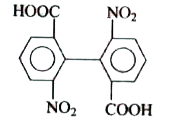Which of the following acids does not exhibit optical isomerism?
Maleic acid
α-amino acids
Lactic acid
Tartaric acid
The correct Answer is:A
To determine which of the following acids does not exhibit optical isomerism, we need to analyze the structures of the given acids and identify whether they have chiral centers or symmetry elements.
1. Understanding Optical Isomerism:
- Optical isomerism occurs in compounds that are optically active, meaning they have chiral centers or lack symmetry elements (like a plane of symmetry, center of symmetry, or axis of symmetry).
2. Analyzing Malic Acid:
- Draw the structure of malic acid. It has the formula C4H6O5.
- Check for chiral centers: Malic acid has no carbon atom bonded to four different groups.
- Conclusion: Malic acid is optically inactive.
3. Analyzing Alpha Amino Acids:
- Draw the general structure of an alpha amino acid (R-CH(NH2)-COOH).
- Identify the chiral center: The carbon atom (C) attached to the amino group (NH2), carboxylic acid (COOH), hydrogen (H), and the R group is a chiral center.
- Conclusion: Alpha amino acids are optically active.
4. Analyzing Lactic Acid:
- Draw the structure of lactic acid (C3H6O3).
- Identify the chiral center: The carbon atom bonded to the hydroxyl group (OH), carboxylic acid (COOH), methyl group (CH3), and hydrogen (H) is a chiral center.
- Conclusion: Lactic acid is optically active.
5. Analyzing Tartaric Acid:
- Draw the structure of tartaric acid (C4H6O6).
- Identify chiral centers: Tartaric acid has two carbon atoms that are each bonded to four different groups.
- Conclusion: Tartaric acid is optically active.
6. Final Conclusion:
- Among the acids analyzed, malic acid is the only one that does not exhibit optical isomerism because it lacks a chiral center.
- Therefore, the correct answer is malic acid.
- Optical isomerism occurs in compounds that are optically active, meaning they have chiral centers or lack symmetry elements (like a plane of symmetry, center of symmetry, or axis of symmetry).
- Draw the structure of malic acid. It has the formula C4H6O5.
- Check for chiral centers: Malic acid has no carbon atom bonded to four different groups.
- Conclusion: Malic acid is optically inactive.
- Draw the general structure of an alpha amino acid (R-CH(NH2)-COOH).
- Identify the chiral center: The carbon atom (C) attached to the amino group (NH2), carboxylic acid (COOH), hydrogen (H), and the R group is a chiral center.
- Conclusion: Alpha amino acids are optically active.
- Draw the structure of lactic acid (C3H6O3).
- Identify the chiral center: The carbon atom bonded to the hydroxyl group (OH), carboxylic acid (COOH), methyl group (CH3), and hydrogen (H) is a chiral center.
- Conclusion: Lactic acid is optically active.
- Draw the structure of tartaric acid (C4H6O6).
- Identify chiral centers: Tartaric acid has two carbon atoms that are each bonded to four different groups.
- Conclusion: Tartaric acid is optically active.
- Among the acids analyzed, malic acid is the only one that does not exhibit optical isomerism because it lacks a chiral center.
- Therefore, the correct answer is malic acid.
Topper's Solved these Questions
- BOOK - ICSECHAPTER - ORGANIC CHEMISTRY : SOME BASIC PRINCIPLES AND TECHNIQUES EXERCISE - TRUE OR FALSE TYPE QUESTIONS50videos
ORGANIC CHEMISTRY : SOME BASIC PRINCIPLES AND TECHNIQUES
- BOOK - ICSECHAPTER - ORGANIC CHEMISTRY : SOME BASIC PRINCIPLES AND TECHNIQUES EXERCISE - FILL IN THE BLANK TYPE QUESTIONS46videos
ORGANIC CHEMISTRY : SOME BASIC PRINCIPLES AND TECHNIQUES
- BOOK - ICSECHAPTER - ORGANIC CHEMISTRY : SOME BASIC PRINCIPLES AND TECHNIQUES EXERCISE - ESSAY ( LONG ANSWER ) TYPE QUESTIONS42videos
ORGANIC CHEMISTRY : SOME BASIC PRINCIPLES AND TECHNIQUES
- BOOK - ICSECHAPTER - HYDROGENEXERCISE - NCERT TEXT-BOOK EXERCISE (With Hints and Solutions)53videos
HYDROGEN
- BOOK - ICSECHAPTER - REDOX REACTIONS (OXIDATION AND REDUCTION)EXERCISE - NCERT TEXT-BOOK. EXERCISES ((With Hints and Solutions)69videos
REDOX REACTIONS (OXIDATION AND REDUCTION)
Similar Questions
Knowledge Check
- Question 1 - Select One or More
Which of the following compounds exhibit optical isomerism?
A BH2C=C=CH2C
BH2C=C=CH2C D
D
- Question 2 - Select One or More
Which of the following compounds can exhibit geometrical isomerism?
AH3C−CH2−CH=CH−CH3B C
C D
D
- Question 3 - Select One
The compound which does not exhibit optical isomerism is
ACH3CHBrCOOHBCH2ClCH2COOHCCH3CHOHCOOC2H5DCH3CHOHCOOH
Which of the following does not show optical isomerism ?
View Solution. Which of the following does not show geometrical isomerism?
View SolutionWhich of the following does not show optical isomerism?
View SolutionWhich of the following does not show optical activity ?
View SolutionWhich of the following cells does not exhibit phagocytic activity ?
View Solution

